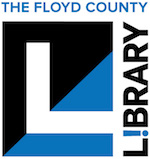George W. Morison (1820-1893), New Albany’s resident artist in the 1800s, is best-known for painting the iconic landscapes of Southern Indiana and portraits of prominent Ohio River Valley citizens. The largest collection of his paintings is held by the Carnegie Center for Art and History, a branch of the Floyd County Library, including the beloved View of New Albany from Silver Hills of 1854.
In the Summer of 2018, news of three rare Morrison paintings of a farmscape and livestock reached the Carnegie Center staff. Eileen Yanoviak and Al Gorman made the journey to Connersville, Indiana, to the family farmstead home of Patricia and Richard Slack to see three previously unrecorded Morrison paintings. The largest painting, measuring 42 x 31 inches, features the home, barn, livestock, and prosperous bounty of the Thornburgh (now Slack) family farm circa 1850. Remarkably, this painting was salvaged from a yard sale by Slack family friend Cheryl Johnson, who unknowingly purchased the damaged Morrison painting to re-purpose the frame. She realized an uncanny resemblance to the Slack family farm.

Before Conservation, George W. Morrison, Untitled (Thornburgh Family Farm, Connersville, Indiana), circa 1850, oil on canvas. Carnegie Center for Art and History, Gift of Cheryl Johnson, 2018.

Above: Slack home, (formerly Thornburgh family) today, Below: Detail of Morrison painting of Thornburgh family farm home, ca 1850.

It so happened that the Slacks also held in their possession two smaller Morrison paintings, one of a cow and one of a pig, that had remained in the home since 1848. Because the home fell into disrepair, the paintings suffered from benign neglect before being saved by Patricia and Richard. Fortunately, both the Slacks and their friend Cheryl recognized it was important to make these paintings available to the public, and they were generously gifted to the Carnegie Center.

Before conservation, George W. Morrison, Untitled (Pig and Cow), Circa 1848, oil on canvas. Carnegie Center for Art and History Collection, Gift of Patricia and Richard Slack, 2018.

No other known Morrison paintings are in the genre of farmstead and livestock portraiture. In the tradition of such artists as Edward Hicks, Morrison provided this successful farming family with an inventory of their most prized possessions and displayed for visitors the source of their wealth and prosperity. In addition to adding diversity to the repertoire of Morrison, the paintings also show Morrison travelled within the state to complete commissions.
For Morrison, Connersville was familiar territory. One of five children, George was born in 1820 in Baltimore to Scottish parents. In the 1830s, the family moved to Connersville, Indiana. George’s brother James moved to New Albany in 1834, and George followed shortly after in 1841. He established a studio at High Street near Bank Street and eventually married and raised a family. In 1851, having achieved success as a portrait, still-life, and landscape painter, he settled in Silver Hills, where he lived and painted until his death in 1893. Morrison’s legacy coincides with many important transitions in New Albany’s history, including the Steamboat Era, the Civil War, and the Industrial Revolution.

Carnegie Center Director, Dr. Eileen Yanoviak, meets with conservator Terry Boyle to discuss the treatment plan.
Given the importance of George W. Morrison in the region’s history and the unique contribution they make to Indiana’s art history, the Carnegie Center has been eager to send these paintings for conservation. The Carnegie Center is excited to announce that David and Donna Reinhardt have sponsored the conservation of all three paintings. In February 2020, Terry Boyle, conservator from Cincinnati-based C.A.G. Framing & Restoration Inc. met with Director Eileen Yanoviak to discuss the approach to conservation and pick up the works. The paintings will return this summer, with a show planned to unveil them in late 2020, the 200th birthday of George W. Morrison.
Special thanks to David and Donna Reinhardt for sponsoring the conservation of three George W. Morrison paintings. Thank you to Richard and Patricia Slack and Cheryl Johnson for donating the artworks to the Carnegie Center for Art and History for the enjoyment and education of generations to come.
Eileen Yanoviak, PhD
Director, Carnegie Center for Art and History, a Branch of the Floyd County Library
Photographs by Al Gorman, Coordinator of Public Programs and Engagement, and Jesse Fox, Marketing Coordinator, Carnegie Center for Art and History


He lived in SILVER HILLS, not Silver Springs. In the late 1800s there were no roads up Silver Hills in New Albany. There was a streetcar that wound around the hill. So homes were built facing the streetcar and the view.
Thanks for catching that typo! I have updated the post. -Best, Eileen
Wonderful story. Can,t wait for a show. I was born In N.A.
I am so pleased U found a sponsor for these rare paintings which I had the priveledge 2 C during the CAP federal grant a few years back. CONGRATS